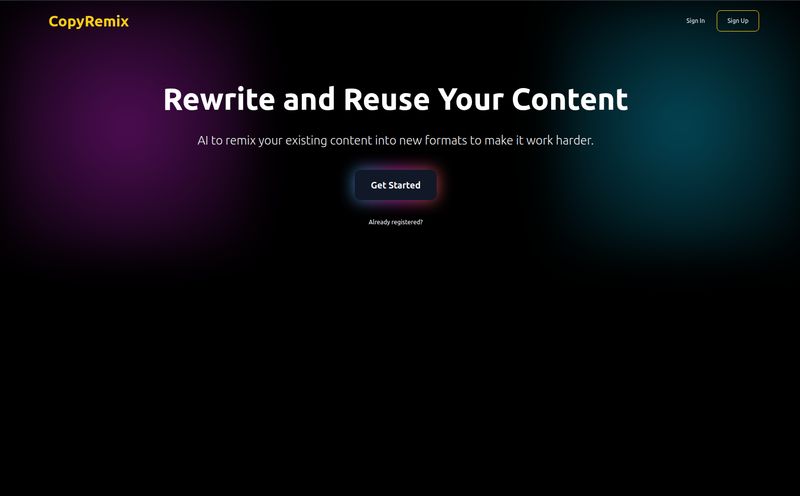We’ve all been there. Staring at that blinking cursor on a stark white screen. It mocks you, doesn't it? That relentless pulse, a tiny digital heartbeat counting down the seconds until your deadline. The client wants a blog post. Your boss needs social media captions. Your own website is gathering more dust than a forgotten attic. This, my friends, is the universal terror of the content creator: the blank page.
For years, we’ve fought it with caffeine, brainstorming sessions, and sheer force of will. But now, there’s a new weapon in the arsenal: AI. And the market is getting… crowded. Every other week, a new AI content generator pops up, promising to be the one-stop-shop for all your writing needs. So when I stumbled upon ContentDojo.io, I’ll admit I was skeptical. Another one? But something about its promise to be more than just a writer—to be an organizer and an idea machine—piqued my interest. So, I rolled up my sleeves and decided to see if it could live up to the hype.

Visit ContentDojo
So, What's the Deal with ContentDojo?
At its core, ContentDojo is an AI-powered platform built to streamline and automate your content production. Think of it less as a ghostwriter and more as a highly efficient, data-driven creative partner. The whole pitch isn't just about writing an article for you; it's about building the entire framework around the article. It helps you find what to write about, organize those thoughts into a logical structure, and then, yes, generate the content.
It’s designed to take you from that initial “uh oh, what do I write?” moment all the way to a finished piece, whether that’s a deep-dive blog post, a snappy social media update, or even a video script. The platform claims to be your all-in-one dojo for mastering content. A bold claim, but I’m here for it.
The Features That Actually Matter
A tool is only as good as its features, right? Here’s what stood out to me as I poked around.
The Idea Generation Engine
This is where ContentDojo first tries to win you over. Instead of just giving you a generic topic, you feed it a keyword. The AI then spits back a ton of relevant content ideas. This is a lifesaver for SEOs trying to build topical authority. One of the testimonials on their site from a guy named Stéphane Jambu mentions this specifically—how it helps cover the entire “champ sémantique” (semantic field). For those of us obsessed with creating content clusters and dominating a niche, this is a pretty big deal. It’s like having a keyword research tool and a brainstorming partner rolled into one.
More Than a List: The Custom Tree Structure
Okay, this is the part that genuinely impressed me. Getting a list of 100 blog ideas is great, but it’s also overwhelming. It's like being handed a phonebook and told to “find a friend.” ContentDojo doesn’t just give you a flat list. It helps you organize these ideas into a custom tree structure. You can map out your main topics, sub-topics, and individual article ideas in a way that actually makes sense. It’s a visual, logical workflow that turns a chaotic brainstorm into an actionable content plan. For agencies or solo marketers juggling multiple projects, this organizational feature alone could be worth the price of admission.
From Idea to Article: Automated Production
Once your ideas are neatly organized, you can tell the AI to get to work. It takes your chosen topic and what it calls “development axes” (basically, your outline or key points) and generates the content. This is the core function, the part that does the heavy lifting. It can produce articles, social media posts, you name it. And it's not just text; they've even baked in AI image generation, which is a nice touch to avoid scrambling for stock photos.
It’s all about efficiency. The goal is to minimize the friction between idea and publication. And I have to admit, the workflow is pretty smooth.
My Experience: The Good, The Bad, and The AI
Look, no tool is perfect. And AI, for all its wonders, is still a long way from replicating the nuanced spark of a human writer. So let’s break down my real-world impressions.
First, the good stuff. This thing is a time-saver, period. The ability to go from a single keyword to a full content plan with dozens of article briefs in under an hour is something that would have sounded like witchcraft five years ago. It obliterates writer's block. You’re never starting from zero. You’re always starting with a foundation, a list of ideas, a rough draft. Another testimonial on their site, from Valérie Vergnest, said it was the best she's tested and that the result required very little rework. That's high praise in the AI space.
The workflow is another huge plus. It’s simple. You don’t need a degree in prompt engineering to get a decent result. It guides you logically from one step to the next, which is fantastic for beginners or teams who just want to get things done without a steep learning curve.
| The Upsides | The Downsides |
|---|---|
| Massively reduces content creation time. | Operates on a credit system for generation. |
| Generates a huge volume of relevant ideas. | Content often needs a human touch for nuance and fact-checking. |
| Excellent organizational tools (the tree structure!). | AI can occasionally produce generic or slightly off-base text. |
| Simple, intuitive workflow. | It's a co-pilot, not a full autopilot solution. |
Now for the not-so-good. The platform runs on credits. This is a common model for AI tools, but it’s something to be aware of. You're not just paying a flat subscription; your usage is metered. This can be great for light users but might get costly if you’re churning out content at a massive scale. You have to be mindful of what you generate.
And the biggest caveat, which applies to all AI writers: the output still needs a human. The AI might write a sentence that’s grammatically perfect but emotionally flat. It might miss a subtle cultural reference or state a “fact” that’s just plain wrong. You absolutely have to edit, fact-check, and inject your own voice and personality into the final product. Thinking you can just copy, paste, and publish is a recipe for bland, soulless content that Google’s helpful content systems will likely ignore. Don't be that person.
Who Is This Tool Really For?
After playing around with it, I can see a few key groups getting a lot of value from ContentDojo:
- SEO Agencies and Freelancers: The ability to quickly build out semantic clusters and content plans for clients is a massive win.
- Small Business Owners: For the owner wearing ten different hats (CEO, marketer, janitor), this can take the content creation hat off their head, or at least make it fit a lot better.
- In-House Marketing Teams: A great tool for scaling content production without having to scale headcount proportionally.
- Bloggers and Affiliate Marketers: Perfect for overcoming writer's block and consistently publishing content to drive traffic.
It's for anyone who understands that content is king but doesn't always have the time or a massive team to feed the royal court.
Let's Talk Money: The Pricing Puzzle
Here's the tricky part. As of my review, the pricing information wasn't readily available in the data I had. The main homepage has a “Tarifs” (Pricing) link in the navigation, but without clicking through and signing up, the exact plans are a bit of a mystery. This is pretty common for SaaS tools in beta or those targeting specific markets (their site seems very French-centric, which is cool).
My advice? If you’re interested, click the “Simuler mon projet” (Simulate my project) or “Découvrir maintenant” (Discover now) buttons on their site. You’ll likely get a clearer picture of the credit system and subscription tiers. I always prefer transparent pricing, but I get the strategy of wanting to get users into the funnel first.
Frequently Asked Questions About ContentDojo
Is ContentDojo easy to use for a beginner?
Absolutely. That’s one of its biggest strengths. The workflow is very guided and intuitive. You don’t need to be an AI wizard to get value from it. If you can type a keyword into a search bar, you can use ContentDojo.
Does ContentDojo replace a human writer or editor?
No, and it's not meant to. Think of it as a powerful assistant or a co-pilot. It handles the grunt work—the research, the initial drafting, the structuring. A human is still needed to provide the final polish, fact-check, inject personality, and ensure the content meets strategic goals. I wouldn't trust any AI tool to run on full autopilot, at least not yet.
What kind of content can I create with it?
Based on their site and features, it’s geared towards a range of digital content. The most obvious are SEO blog posts and articles, but it's also set up for e-commerce product descriptions, social media campaigns, and even corporate communications. The inclusion of video script generation is also an interesting angle for creators on platforms like YouTube.
How does the credit system work?
While the exact rates aren't public, credit systems in AI tools typically charge you for specific actions. For example, generating a set of ideas might cost X credits, and writing a full 1,000-word article might cost Y credits. This allows you to pay for what you use, but you'll need to monitor your balance.
Is the tool only available in French?
The homepage I landed on was in French, and the testimonials are from French professionals. However, the .io domain and the nature of AI suggest it's likely capable of handling English and other languages. I would test it out during the trial or simulation phase to confirm its capabilities in your primary language.
Final Thoughts: Is ContentDojo Your Next Secret Weapon?
So, what’s the final verdict? I came in skeptical, and I’m walking away pleasantly surprised. ContentDojo isn’t just another AI-powered text spinner. Its strength lies in its structured, organized approach. The focus on building a content plan before you write is smart and genuinely useful for anyone serious about a long-term content strategy.
It’s not a magic bullet. You can’t fire your writing team and replace them with this tool. But you can arm them with it to make them faster, more efficient, and free them from the soul-crushing dread of the blank page. If you’re struggling with content volume or just need a powerful brainstorming partner, I think ContentDojo is absolutely worth a look. It’s a well-designed tool that understands the real workflow of a content creator, and in this noisy AI market, that's a rare and valuable thing.



